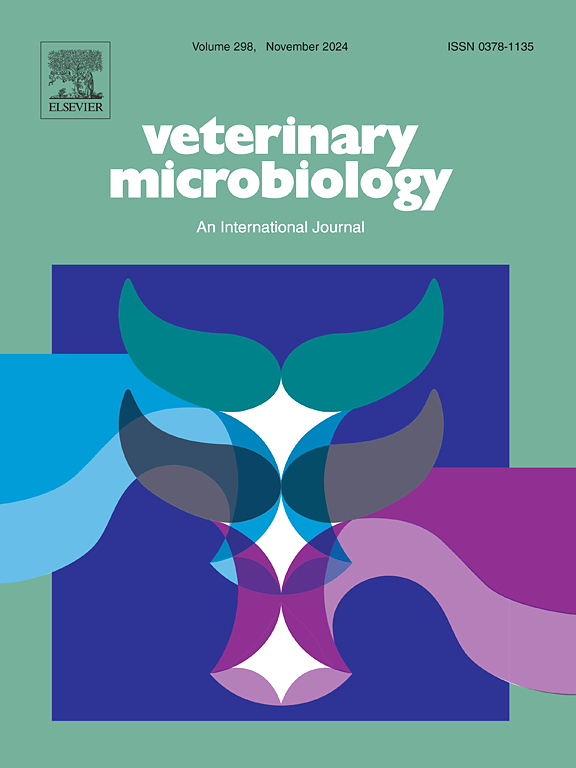The rabies virus matrix protein (RABV M) interacts with host histone deacetylase 6 (HDAC6) to activate the MEK/ ERK signaling pathway and enhance viral replication
IF 2.4
2区 农林科学
Q3 MICROBIOLOGY
引用次数: 0
Abstract
Rabies virus (RABV) is the causative agent of rabies, posing a severe threat to human and animal health. The matrix (M) protein of RABV plays crucial roles during viral infection. In this study, we identified RABV M protein interacted with host histone deacetylase 6 (HDAC6) through a combination of immunoprecipitation and mass spectrometry analysis. Specifically, the catalytic domains of HDAC6 (amino acids 435–835) was shown to be critical for the interaction between HDAC6 and the RABV M protein. Overexpression of HDAC6 significantly enhanced RABV replication, whereas inhibition of HDAC6 expression or its deacetylase activity had the opposite effect,indicating that HDAC6 is a positive regulator of RABV replication. We further determined that RABV infection actives the MEK/ERK pathway, and inhibition of this pathway with U0126 significantly reduced viral titers. Moreover, HDAC6 positively regulated MEK/ERK pathway activation in a manner independent of its deacetylase activity but dependent on the presence of HDAC6 during virus infection. Finally, we demonstrated that co-expression of RABV M enhanced the role of HDAC6 in facilitating MEK/ERK pathway activation. Collectively, our findings demonstrate that RABV exploits the HDAC6-M interaction to hijack the MEK/ERK signaling axis, which is essential for viral replication. Notably, HDAC6 facilitates MEK/ERK activation in a deacetylase activity-independent manner, revealing a novel mechanism by which viruses manipulate host machinery. These results highlight HDAC6 as a potential therapeutic target for combating rabies.
狂犬病毒基质蛋白(RABV M)与宿主组蛋白去乙酰化酶6 (HDAC6)相互作用,激活MEK/ ERK信号通路,增强病毒复制
狂犬病毒(RABV)是狂犬病的病原体,对人类和动物的健康构成严重威胁。RABV基质(M)蛋白在病毒感染过程中起着至关重要的作用。在本研究中,我们通过免疫沉淀和质谱分析相结合的方法鉴定了RABV M蛋白与宿主组蛋白去乙酰化酶6 (HDAC6)相互作用。具体来说,HDAC6的催化结构域(氨基酸435-835)被证明是HDAC6与RABV M蛋白相互作用的关键。过表达HDAC6可显著增强RABV的复制,而抑制HDAC6的表达或其去乙酰化酶活性则具有相反的作用,表明HDAC6是RABV复制的正调控因子。我们进一步确定RABV感染激活MEK/ERK途径,U0126抑制该途径可显著降低病毒滴度。此外,HDAC6正向调节MEK/ERK通路的激活,其方式独立于其去乙酰化酶活性,但依赖于病毒感染期间HDAC6的存在。最后,我们证明RABV M的共表达增强了HDAC6在促进MEK/ERK通路激活中的作用。总之,我们的研究结果表明RABV利用HDAC6-M相互作用劫持MEK/ERK信号轴,这对病毒复制至关重要。值得注意的是,HDAC6以不依赖于去乙酰化酶活性的方式促进MEK/ERK的激活,揭示了病毒操纵宿主机制的新机制。这些结果强调了HDAC6作为对抗狂犬病的潜在治疗靶点。
本文章由计算机程序翻译,如有差异,请以英文原文为准。
求助全文
约1分钟内获得全文
求助全文
来源期刊

Veterinary microbiology
农林科学-兽医学
CiteScore
5.90
自引率
6.10%
发文量
221
审稿时长
52 days
期刊介绍:
Veterinary Microbiology is concerned with microbial (bacterial, fungal, viral) diseases of domesticated vertebrate animals (livestock, companion animals, fur-bearing animals, game, poultry, fish) that supply food, other useful products or companionship. In addition, Microbial diseases of wild animals living in captivity, or as members of the feral fauna will also be considered if the infections are of interest because of their interrelation with humans (zoonoses) and/or domestic animals. Studies of antimicrobial resistance are also included, provided that the results represent a substantial advance in knowledge. Authors are strongly encouraged to read - prior to submission - the Editorials (''Scope or cope'' and ''Scope or cope II'') published previously in the journal. The Editors reserve the right to suggest submission to another journal for those papers which they feel would be more appropriate for consideration by that journal.
Original research papers of high quality and novelty on aspects of control, host response, molecular biology, pathogenesis, prevention, and treatment of microbial diseases of animals are published. Papers dealing primarily with immunology, epidemiology, molecular biology and antiviral or microbial agents will only be considered if they demonstrate a clear impact on a disease. Papers focusing solely on diagnostic techniques (such as another PCR protocol or ELISA) will not be published - focus should be on a microorganism and not on a particular technique. Papers only reporting microbial sequences, transcriptomics data, or proteomics data will not be considered unless the results represent a substantial advance in knowledge.
Drug trial papers will be considered if they have general application or significance. Papers on the identification of microorganisms will also be considered, but detailed taxonomic studies do not fall within the scope of the journal. Case reports will not be published, unless they have general application or contain novel aspects. Papers of geographically limited interest, which repeat what had been established elsewhere will not be considered. The readership of the journal is global.
 求助内容:
求助内容: 应助结果提醒方式:
应助结果提醒方式:


